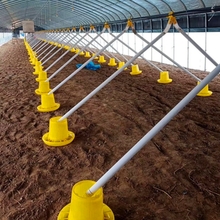Efficient Solutions for Blending Animal Feed with Advanced Mixer Technology
ធ្នូ . 13, 2024 06:57 Back to list
Efficient Solutions for Blending Animal Feed with Advanced Mixer Technology
The Importance of Feed Mixers in Modern Agriculture
In the world of modern agriculture, efficient feeding systems are crucial for ensuring optimal nutrition and productivity in livestock. One of the pivotal tools in this context is the feed mixer. This piece of equipment plays a vital role in the preparation of animal feed, directly influencing the health and growth of animals and the overall profitability of farms.
Understanding Feed Mixers
At its core, a feed mixer is a specialized machine designed to blend various ingredients into a uniform feed ration for livestock. These machines come in various types, including vertical, horizontal, and paddle mixers. Each has its unique mechanism and advantages, yet they all serve the same fundamental purpose to ensure that animals receive a balanced diet that meets their nutritional needs.
Enhancing Nutritional Value
One of the primary benefits of using a feed mixer is its ability to create a homogeneous mixture of ingredients. Livestock, whether cattle, pigs, or poultry, require a specific balance of nutrients, including proteins, vitamins, and minerals. A well-mixed feed guarantees that every bite the animal takes contains the necessary nutrients for growth, reproduction, and overall health. This is particularly important as discrepancies in feed distribution can lead to nutritional deficiencies, affecting animal performance and leading to increased veterinary costs.
Efficiency and Cost Savings
Using a feed mixer can significantly enhance the efficiency of feed preparation
. Traditionally, farmers would mix feed manually, a labor-intensive process that not only consumed time but also led to inconsistencies in the feed mix. With the advent of feed mixers, this process has become streamlined. These machines can handle larger volumes and ensure a rapid mixing process, allowing farmers to save precious time and labor costs. Additionally, a well-mixed feed ration can lead to better feed conversion ratios, meaning animals utilize feed more effectively, which translates to reduced feed costs.feed mixer

Customization for Different Livestock
Different types of livestock have unique dietary requirements. A feed mixer allows farmers to customize feed formulations to cater to the specific needs of various animals. For instance, the nutritional needs of a milk-producing cow differ vastly from those of a growing pig or a laying hen. By using a feed mixer, farmers can experiment with and modify feed recipes, incorporating different grains, supplements, and additives to create the ideal diet for each species, age, or production stage.
Reducing Waste
Food waste is a significant concern in agriculture, not only from an economic standpoint but also in terms of sustainability. Feed mixers help reduce waste by ensuring that feed is evenly mixed and appropriately formulated. The precision offered in measuring and mixing can lead to the elimination of over-formulation, where excess ingredients are used without being fully consumed. This not only reduces waste but also helps manage the environmental impact of livestock farming.
The Future of Feed Mixing
As agriculture continues to evolve, so too does the technology behind feed mixers. Innovations such as automated feed delivery systems and smart mixers are on the horizon. These advancements promise to further enhance accuracy in feed preparation and reduce the manual labor required. Additionally, integrating data management systems into feed mixers will allow farmers to track nutrition and consumption patterns in real-time, making adjustments as necessary to optimize animal health and farm efficiency.
Conclusion
In conclusion, feed mixers are indispensable tools in the modern agricultural landscape. Their ability to create uniform, nutritious feed plays a crucial role in ensuring the health and productivity of livestock. By enhancing feed efficiency, reducing waste, and allowing for customization, these machines contribute significantly to the sustainability and profitability of farming operations. As technology continues to advance, the feed mixer will likely evolve further, solidifying its place as a cornerstone in the realm of animal husbandry. Farmers who embrace these innovations will be better equipped to meet the challenges of modern agriculture and ensure the well-being of their livestock.
-
High Performance Exhaust Fan – Efficient Ventilation Solutions for Home
NewsJun.10,2025
-
High-Quality Gestation Pen for Sows Durable Mobile Pig Pen & Simple Pig Pen Solutions
NewsJun.10,2025
-
High Quality Rabbit Cage Double Tier Designs & Welded Wire Mesh Supplier
NewsJun.10,2025
-
Floating Fish Feed Machine - High Efficiency Floating Fish Feed Extruder for Small Scale Production
NewsJun.10,2025
-
Premium Poultry Housing Solutions Mobile & Commercial Free Range Options
NewsJun.10,2025
-
Industrial FRP Fans Corrosion-Resistant Blades & Centrifugal Systems
NewsJun.09,2025






